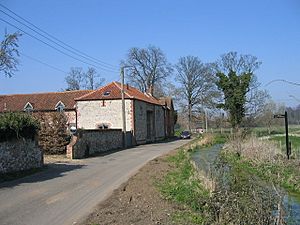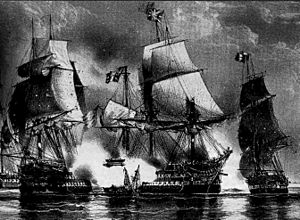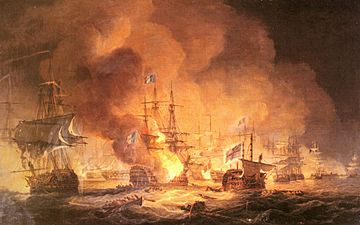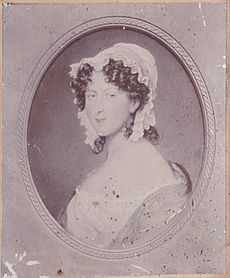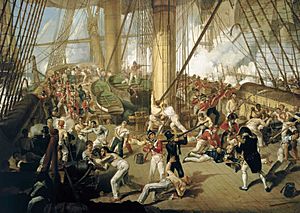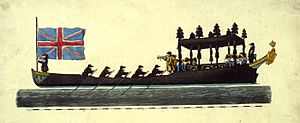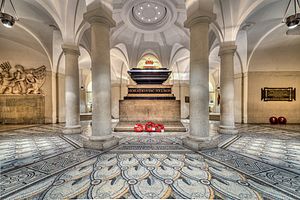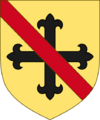Horatio Nelson, 1st Viscount Nelson facts for kids
Quick facts for kids
Vice-Admiral The Right Honourable
The Viscount Nelson
|
|
|---|---|
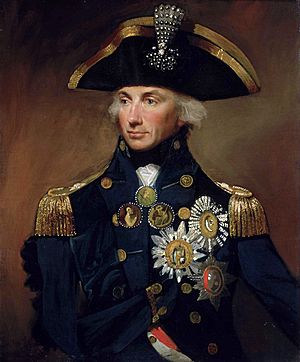
Portrait of Nelson by L. F. Abbott (1799)
|
|
| Born | 29 September 1758 Burnham Thorpe, England
|
| Died | 21 October 1805 (aged 47) HMS Victory, off Cape Trafalgar, Spain
|
| Burial place | St Paul's Cathedral |
| Spouse(s) |
Frances Nisbet
(m. 1787) |
| Parent(s) | Edmund Nelson Catherine Suckling |
| Military career | |
| Service/ |
Royal Navy |
| Years of service | 1771–1805 |
| Rank | Vice-Admiral of the White |
| Commands held | Mediterranean Fleet |
| Battles/wars | |
| Awards | Knight of the Order of the Bath |
| Signature | |
Vice-Admiral Horatio Nelson (born September 29, 1758 – died October 21, 1805) was a famous British naval officer. He served in the Royal Navy and is known for his amazing leadership. His smart plans and new ways of fighting helped Britain win many important naval battles. These victories happened during the French Revolutionary and Napoleonic Wars. Many people see him as one of the greatest naval commanders ever.
Nelson grew up in a well-off family in Norfolk, England. He joined the navy because his uncle, Maurice Suckling, was a high-ranking officer. Nelson quickly moved up the ranks. By age 20, in 1778, he was in charge of his own ship. He became known for his bravery and good battle plans.
He faced times of illness and unemployment after the American War of Independence ended. But when the French Revolutionary Wars began, Nelson returned to duty. He was very active in the Mediterranean Sea. He fought in small battles and helped capture Corsica. There, he was hurt and partly lost sight in one eye.
In 1797, he showed great skill at the Battle of Cape St Vincent. Soon after, he took part in the Battle of Santa Cruz de Tenerife. This attack failed, and he lost his right arm. He had to go back to England to get better. The next year, he won a huge victory against the French at the Battle of the Nile. He stayed in the Mediterranean to help the Kingdom of Naples against a French invasion.
In 1801, Nelson went to the Baltic Sea. He defeated Denmark at the Battle of Copenhagen. He then blocked the French and Spanish fleets at Toulon. They escaped, and he chased them all the way to the West Indies and back. But he could not get them to fight.
After a short time in England, he took over the Cádiz blockade in 1805. On October 21, 1805, the Franco-Spanish fleet left port. Nelson's fleet met them at the Battle of Trafalgar. This battle became one of Britain's greatest naval wins. But Nelson, on his ship HMS Victory, was badly wounded by a French sharpshooter. He died during the battle.
Nelson's death at Trafalgar made him a British hero. His famous signal before the battle, "England expects that every man will do his duty", is still quoted today. Many monuments, like Nelson's Column in Trafalgar Square, London, honor his memory.
Contents
- Horatio Nelson: Britain's Naval Hero
- Titles
- Images for kids
- See also
Horatio Nelson was born on September 29, 1758. He was born in a rectory in Burnham Thorpe, Norfolk, England. He was the sixth of eleven children. His parents were Reverend Edmund Nelson and Catherine Suckling.
Nelson's uncle, Maurice Suckling, was a high-ranking naval officer. He greatly influenced Nelson's life. Nelson went to school until he was 12 years old.
His navy career began on January 1, 1771. He joined HMS Raisonnable as an ordinary seaman. His uncle, Captain Maurice Suckling, commanded this ship. Soon after, Nelson became a midshipman and started officer training. Early in his service, he found out he got seasickness. This problem stayed with him his whole life.
Adventures at Sea
Nelson gained experience at sea on a merchant ship called Mary Ann. He sailed to Jamaica and Tobago. He crossed the Atlantic Ocean twice. Then he returned to serve under his uncle.
In 1773, Nelson joined an expedition to the Arctic. They tried to find a passage to India. The ships got stuck in ice. A story says Nelson chased a polar bear to get its skin for his father.
Nelson then went to the East Indies on HMS Seahorse. He arrived at Madras in May 1774. He spent time cruising and protecting merchant ships. In 1775, he had his first battle experience. Two enemy ships attacked Seahorse, but they were driven off.
In early 1776, Nelson got very sick with malaria. He had to return to England. His uncle, now a high-ranking officer, helped him get promoted. Nelson became an acting lieutenant on HMS Worcester.
He passed his lieutenant's examination in April 1777. The next day, he joined HMS Lowestoffe. This ship sailed to Jamaica. During the American War of Independence, Lowestoffe captured several enemy ships. Nelson was given command of one of these, Little Lucy. This was his first time commanding a ship.

Nelson's skills impressed his captain, William Locker. Locker recommended him to the commander-in-chief in Jamaica, Sir Peter Parker. Parker took Nelson onto his flagship, HMS Bristol. Nelson was promoted to Master and Commander of HMS Badger in December 1778.
In 1779, Nelson was promoted to post-captain. He was given command of HMS Hinchinbrook. He took part in an attempt to capture Spanish colonies in Central America. This included an attack on the Fortress of the Immaculate Conception in Nicaragua. Nelson was praised for his efforts.
He fell seriously ill again in 1780. He was sent back to Britain to recover. After several months, he was given command of HMS Albemarle in August 1781.
Nelson's Views on Slavery
While in the West Indies, Nelson became friends with some plantation owners. They believed slavery was needed for the islands' economy. Nelson's wife, Fanny, also came from a family that owned slaves.
Nelson's actions show his position on slavery. Any slave who escaped to a navy ship, including Nelson's, was signed on and paid like other crew members. They were set free after their service. A panel on Nelson's Column even shows a black sailor, George Ryan, fighting alongside Nelson.
In 1799, Nelson helped free 24 slaves held in Portuguese ships. In 1802, he supported the idea of replacing slaves with free Chinese workers. In 1805, Nelson rescued a black Haitian General, Joseph Chretien, and his servant from the French. Nelson knew the General wanted to end slavery.
A letter published after Nelson's death in 1807 seemed to show him strongly against the end of slavery. However, comparisons with the original letter show it was changed. About 25 alterations were made to make it sound more anti-abolitionist.
Captain of Albemarle and Marriage
In October 1781, Nelson took Albemarle to sea. He escorted a convoy from Elsinore back to Britain. The ship was poorly designed and damaged, but Nelson brought her safely to Portsmouth.
In 1782, Nelson had a close call with a much stronger French force. He managed to escape after a long chase. He also planned an attack on the Turks Islands. The attack failed, but Nelson was not blamed. He spent the rest of the war in the West Indies, capturing French and Spanish ships.
After the war, Nelson visited France. He returned to England in January 1784. He was given command of HMS Boreas. His job was to enforce trade laws in Antigua. These laws were not popular. Nelson seized American ships, and their captains sued him. Nelson stayed on his ship for eight months until the courts ruled in his favor.
During this time, Nelson met Frances "Fanny" Nisbet. She was a young widow from Nevis. They married on March 11, 1787. Nelson returned to England in July, and Fanny followed later.
Nelson was on half-pay for several years, meaning he was not actively working. He tried to get a new command but could not. In 1792, the British navy called him back to service. He was given command of HMS Agamemnon in January 1793. On February 1, France declared war.
Mediterranean Service and Injuries
In May 1793, Nelson sailed to the Mediterranean. He was part of Lord Hood's fleet. They went to Toulon. The city asked Hood for protection from the French army. Hood agreed and sent Nelson to get more troops from Sardinia and Naples.
In Naples, Nelson met King Ferdinand IV of Naples and the British ambassador, William Hamilton. He also met Hamilton's wife, Emma Hamilton. Nelson successfully got reinforcements.
He arrived back at Toulon in October. The French army was attacking the city. Nelson was sent to blockade the French on Corsica. In February 1794, British troops landed on Corsica. Nelson helped with the Siege of Bastia. He brought guns from his ships to attack the town. After 45 days, Bastia surrendered.
Nelson then prepared for an attack on Calvi. On July 12, a shot hit a sandbag near Nelson. Stones and sand sprayed, hitting his right eye. He was hurt but returned to action. Calvi surrendered on August 10. Nelson could only see light and dark with his injured eye.
The Fight of the Ça Ira
After Corsica, Nelson was ordered to talk with the city-state of Genoa. Admiral William Hotham became the new commander. Nelson sailed with the fleet.
On March 8, 1795, the French fleet was spotted. Nelson's ship, Agamemnon, engaged the much larger French ship, the 84-gun Ça Ira. Nelson caused a lot of damage to the French ship.
On March 14, in the Battle of Genoa, Nelson helped attack the damaged Ça Ira. It was being towed by another French ship. Both French ships surrendered. Nelson captured Censeur. The French then gave up their plan to invade Corsica.
Nelson stayed in the Mediterranean. He tried to stop French advances in Italy. In June, Agamemnon was sent for repairs. Nelson was given command of the 74-gun HMS Captain.
The French advanced on Leghorn. Nelson helped evacuate British citizens to Corsica. By October, the British decided they could no longer supply their fleet in the Mediterranean. They ordered it to withdraw to Gibraltar. Nelson helped with the withdrawal from Corsica.
Becoming an Admiral
In January 1796, Sir John Jervis took command of the Mediterranean fleet. He made Nelson a commodore. Nelson was in charge of ships blocking the French coast.
Battle of Cape St Vincent
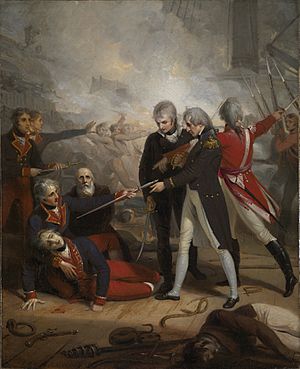
Nelson joined Sir John Jervis' fleet off Cape St Vincent on February 14, 1797. Nelson was at the back of the British line. He realized it would take too long to join the fight. So, he disobeyed orders. He turned his ship, Captain, and headed straight for the Spanish ships.
Captain fought three large Spanish ships. After an hour, Nelson's ship was badly damaged. He led a boarding party onto the Spanish ship San Nicolas. He yelled, "Westminster Abbey or glorious victory!" He forced her to surrender. The San Josef tried to help, but got stuck. Nelson then led his party from San Nicolas onto San Josef and captured her too.
The Spanish fleet retreated. Four ships surrendered to the British, and two were captured by Nelson. Nelson had disobeyed orders, but Jervis did not punish him. Nelson was made a Knight of the Bath. On February 20, he was promoted to Rear Admiral of the Blue.
Wounded at Santa Cruz de Tenerife
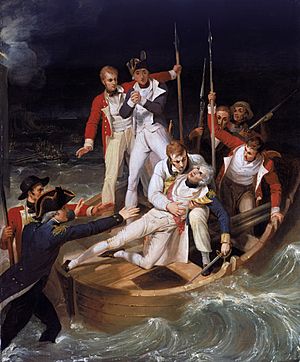
Nelson was given HMS Theseus as his flagship. In July 1797, he led an attack on Santa Cruz de Tenerife. He hoped to capture a treasure ship. The attack failed. The Spanish were well prepared.
Nelson personally led one of the groups. As he stepped ashore, a musket ball hit his right arm. It broke his arm in many places. He was taken back to Theseus. He refused help getting aboard, saying, "Let me alone! I have yet legs left and one arm." His right arm was amputated. Within half an hour, Nelson was giving orders again.
The British force had to withdraw. The expedition failed, and many British soldiers were killed or wounded. Nelson wrote to Jervis, "A left-handed Admiral will never again be considered as useful." He returned to England. He was welcomed as a hero. The public blamed the defeat on poor planning by others, not Nelson.
Return to England
Nelson went to Bath with his wife, Fanny. Then they moved to London for his medical care. He was awarded the Freedom of the City of London and a pension of £1,000 a year. He planned to retire.
His wound healed well. He was eager to return to sea. He was given command of HMS Vanguard. In March 1798, Nelson sailed to Toulon to check on French activities.
The Battle of the Nile
Nelson's squadron was hit by a strong storm. Meanwhile, Napoleon sailed with his invasion fleet to Malta. Nelson chased him, but Napoleon had already left. Nelson guessed Napoleon was heading for Egypt.
Nelson arrived at Alexandria on June 28, but saw no French ships. He left to search elsewhere. On July 1, Napoleon's fleet arrived in Alexandria. Their commander, François-Paul Brueys d'Aigalliers, anchored his fleet in Aboukir Bay.
Nelson returned to Alexandria for a final check. He found the French fleet in Aboukir Bay on August 1, 1798. Nelson immediately prepared for battle. He said, "Before this time tomorrow, I shall have gained a peerage or Westminster Abbey."
The French did not expect an attack because it was late. Their ships were anchored close to shallow waters, thinking this would protect one side. But Captain Thomas Foley found a gap. He took his ship, HMS Goliath, into this channel. The French were attacked from both sides.
Nelson's ship, Vanguard, fought the French ships. Around eight o'clock, Nelson was hit in the forehead by a French shot. He fell, thinking he would die. He was taken below deck. The surgeon said the wound was not life-threatening.
The French ships began to surrender. The British ships moved down the line, attacking the French flagship, Orient. Orient caught fire and later exploded. Nelson briefly came back on deck to see the battle.
The Battle of the Nile was a huge defeat for Napoleon. His fleet was destroyed. Only two ships and two frigates escaped. Napoleon's army in Egypt was stranded. This victory was very important for Britain.
Life in Naples and Return to England
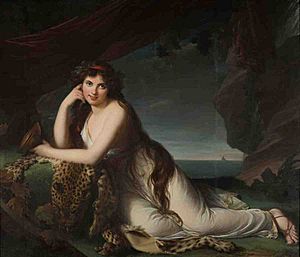
Nelson sailed to Naples after the battle. He was met with great celebrations. King Ferdinand IV and the Hamiltons greeted him. Nelson stayed at the Hamiltons' home. He became very close with Emma Hamilton.
News of Nelson's victory reached London. There were huge celebrations across Britain. The King gave Nelson and his captains special medals. The Sultan of the Ottoman Empire gave Nelson a diamond decoration. Nelson was given the title of Baron Nelson of the Nile. He was disappointed he didn't get a higher title.
Nelson enjoyed his time in Naples. He was ordered to blockade French forces in Alexandria and Malta. King Ferdinand IV declared war on France. The Neapolitan army, with Nelson's fleet, retook Rome. But the French fought back and routed the Neapolitans.
Nelson quickly organized the evacuation of the Royal Family and British citizens, including the Hamiltons, to Palermo. Naples fell into chaos. The French entered the city and created the Parthenopaean Republic.
Nelson was promoted to Rear-Admiral of the Red in February 1799. He blockaded Naples while a local force, the Sanfedisti, marched to retake the city. In June, the Sanfedisti entered Naples. The French and their supporters retreated to the city's forts.
A treaty was made for the French and their supporters to leave safely. Nelson arrived and was very angry. He insisted they surrender without conditions. They refused. Nelson then had the transports seized. He handed many over for trial and execution. This part of his actions is still debated by historians.
King Ferdinand IV made Nelson the Duke of Bronte in Sicily. Nelson also received an estate.
In 1800, Nelson helped with the siege of Malta. He captured a French ship, Généreux. Nelson and Emma Hamilton lived openly together during a cruise around Malta. Their daughter, Horatia, was likely conceived during this time.
Nelson had a difficult relationship with his superior officer, Lord Keith. He sometimes refused to send ships or returned to port without orders.
Return to England
Nelson returned to England with the Hamiltons. They traveled through Europe, stopping in cities like Vienna and Prague. They arrived in Great Yarmouth in November. Nelson was welcomed as a hero. He then went to London.
Nelson attended many events. His wife, Fanny, met Emma Hamilton. Nelson was cold to Fanny, and his closeness with Emma became gossip. Their marriage broke down. They never lived together again.
The Baltic Campaign
Nelson became second-in-command of the Channel Fleet. He was promoted to Vice-Admiral of the Blue in January 1801. On January 29, 1801, Emma Hamilton gave birth to their daughter, Horatia.
Russia, Prussia, Denmark, and Sweden formed an alliance against Britain. Nelson was sent to the Baltic. He joined Admiral Hyde Parker's fleet. Nelson urged an attack on the Danish fleet in Copenhagen harbor. Parker agreed.
Battle of Copenhagen
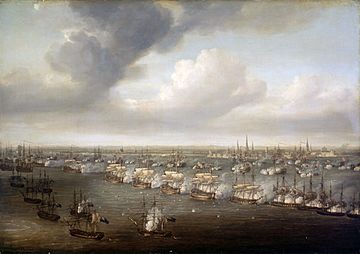
On April 2, 1801, Nelson's ships advanced into Copenhagen harbor. The battle started badly. Some British ships ran aground. The Danish shore batteries fired heavily.
Nelson was on HMS Elephant. He was told of a signal to retreat. He famously put his telescope to his blind eye and said, "I really do not see the signal." He continued the attack.
The battle lasted three hours. Both sides were heavily damaged. Nelson sent a letter to the Danish commander, calling for a truce. The Prince accepted. Nelson later said it was the hardest battle he had ever fought.
Nelson became commander-in-chief in the Baltic Sea. He was made Viscount Nelson of the Nile. He returned to England in July.
Final Years and Trafalgar
Napoleon was planning to invade Britain. Nelson was put in charge of defending the English Channel. He scouted the French coast. There was a failed attack on Boulogne in August. In October, the Peace of Amiens was signed. Nelson retired again.
He stayed with William and Emma Hamilton. In the summer of 1802, Nelson and the Hamiltons toured England and Wales. Nelson was often welcomed as a hero. Emma Hamilton bought Merton Place, a country estate, for Nelson. He lived there with the Hamiltons until William's death in April 1803.
War broke out again the next month. Nelson prepared to return to sea.
Return to Sea
Nelson became commander-in-chief of the Mediterranean Fleet. His flagship was the HMS Victory. He sailed to Malta and then joined the blockade of Toulon. He spent a year and a half enforcing the blockade. He was promoted to Vice-Admiral of the White in April 1804.
In January 1805, the French fleet, led by Admiral Pierre-Charles Villeneuve, escaped Toulon. Nelson chased them. Villeneuve escaped again in April, sailing to the West Indies. Nelson chased them there, but could not find them. Villeneuve returned to Europe.
Nelson returned to England in July. He was upset he hadn't fought the French fleet. But he received a warm welcome from the public. He stayed with Emma Hamilton at Merton Place. He planned a big battle against the enemy fleet.
He met Arthur Wellesley (the future Duke of Wellington) briefly. Nelson returned to Merton to say goodbye to Emma. He then traveled to Portsmouth. A large crowd cheered him on. He said, "I had their huzzas before; I have their hearts now."
Victory joined the British fleet off Cádiz on September 27. Nelson took command. He spent weeks planning his tactics. He decided to split his fleet into squadrons. These squadrons would cut through the enemy's line. This would create a close-quarters battle. British ships could then overwhelm parts of the enemy formation.
Battle of Trafalgar
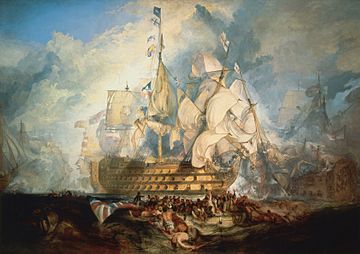
The combined French and Spanish fleet had thirty-three ships. Napoleon wanted them to sail to the English Channel for an invasion. But he changed his plans. Villeneuve decided to sail out before a new commander arrived. On October 20, 1805, the fleet left harbor. Nelson was informed they were heading west.
At 4 AM on October 21, Nelson ordered Victory to turn towards the enemy. He signaled his fleet to battle stations. He went below to make his will. He then returned to the deck. Nelson was confident, even with fewer ships. He said he wanted to capture at least twenty enemy ships.
Nelson's signal lieutenant suggested changing "England confides that every man will do his duty" to "England expects that every man will do his duty." This was easier to signal. Nelson agreed, and the famous signal was hoisted.
Victory came under fire. A cannonball killed Nelson's secretary. Another killed a clerk. Victory's wheel was shot away. Eight marines were killed. Nelson said, "This is too warm work to last long."
Victory reached the enemy line. Nelson told Captain Thomas Hardy to pick a ship to attack. Hardy moved Victory behind the French flagship, Bucentaure. Victory also came under fire from Redoutable and Santísima Trinidad. Sharpshooters fired from the enemy ships' rigging.
Wounding and Death
At 1:15 PM, Nelson was shot. A musket ball from Redoutable hit his left shoulder. It went through a lung and his spine. He fell to the deck. He was carried below to the ship's hospital area. He asked them to pause so he could give advice to a young officer. He covered his face with a handkerchief so the crew wouldn't be alarmed.
Nelson was made comfortable. He asked to see Hardy several times. He asked his surgeon to remember him to Emma and his daughter.
Hardy came below at 2:30 PM. He told Nelson that many enemy ships had surrendered. Nelson said he was sure he would die. He asked Hardy to give his things to Emma. Nelson told Hardy to make sure the fleet anchored because a gale was coming. He then said, "Kiss me, Hardy." Hardy knelt and kissed Nelson.
Nelson became very weak. He kept murmuring instructions. His last words were, "God and my country." Nelson died at 4:30 PM, three hours after being shot. He was 47 years old.

A Hero's Funeral
Nelson's body was put in a cask of brandy. It was taken to Gibraltar, then transferred to a lead-lined coffin filled with spirits. The coffin was then placed inside a wooden one, made from the mast of the French ship L'Orient, which had been salvaged after the Battle of the Nile.
He lay in state for three days at Greenwich Hospital. Huge crowds came to see him. His body was then taken upriver on a royal barge.
On January 9, 1806, a large funeral procession took the coffin to St Paul's Cathedral. Thirty-two admirals, over a hundred captains, and 10,000 soldiers were part of it. After a four-hour service, he was buried in a crypt. The sarcophagus was originally made for Cardinal Wolsey. Sailors tore the flag that was to be placed on his coffin, each taking a piece as a keepsake.
Nelson's Legacy
Nelson was seen as a very good leader. He cared about his men. He led with love, not just authority. He inspired everyone with his courage and charm, known as "the Nelson touch". He was also smart at strategy and politics.
Nelson loved to be noticed. He was happy when praised and upset if he didn't get enough credit. He took risks and liked to share his successes. He was very confident and good at making decisions. He knew his enemies well and could find their weaknesses.
He sometimes had mood swings and was vain. But he was a professional leader. He was always driven by a strong sense of duty. After his death, Nelson became one of Britain's greatest military heroes. In 2002, he was voted the ninth greatest Briton ever.
Some parts of Nelson's life were controversial. His close relationship with Emma Hamilton was widely talked about. She was not allowed to attend his funeral. The government did not support Emma or their daughter, Horatia.
Nelson's actions in Naples also caused debate. Some people criticized his approval of executions after the city was retaken. Others say his actions were normal for the time. They also say he helped restore order.
Monuments and Memorials
Nelson's influence continued long after his death. He was often remembered during times of crisis in Britain. He has been shown in many paintings and books. He is also honored in songs. The composer Haydn wrote a mass to celebrate Nelson's victory over Napoleon. Nelson met Haydn and gave him a watch he wore during battle.
Many monuments were built to honor Nelson. The city of Nelson in New Zealand is named after him. Nelson's Column in Trafalgar Square, London, was finished in 1843. A Royal Society of Arts blue plaque marks his home at 147 New Bond Street.
However, some monuments to Nelson have been removed. This happened in countries that felt the negative effects of colonialism. In 1966, Nelson's Pillar in Dublin was blown up by Irish Republicans. In 2020, the Nelson Statue in Bridgetown, Barbados, was moved to a museum. The Prime Minister of Barbados said that public spaces should reflect their own heroes.
Titles
Nelson received special medals for the battles of St Vincent, the Nile, and Trafalgar. He was allowed to wear the foreign Order of Saint Joachim.
He was a Colonel of Marines and given the title of Freeman in many cities. The University of Oxford gave him an honorary degree.
In 1799, King Ferdinand III of Sicily made Nelson the Duke of Bronte in Sicily. Nelson signed his name "Nelson & Brontë" for the rest of his life. Nelson had no legitimate children. His daughter, Horatia, had ten children.
Since Nelson had no legitimate children, his titles from 1798 became extinct when he died. However, the barony created in 1801 passed to his older brother, William Nelson. In November 1805, William Nelson was made Earl Nelson and Viscount Merton to honor his brother's service. He also inherited the dukedom of Bronte.
Armorial bearings
Nelson's family arms were changed to honor his naval victories. After the Battle of Cape St Vincent, he was given supporters for his shield: a sailor and a lion.
After the Battle of the Nile in 1798, the Crown added more to his arms. This included a palm tree, a damaged ship, and a ruined battery. His motto became Palmam qui meruit ferat ("let him who has earned it bear the palm"). Palm branches were added to the sailor and lion. A "tri-colored flag" of the defeated enemy was added to the lion's mouth.
After Nelson's death, his brother William was given another addition: the word "TRAFALGAR" on a blue wavy stripe.
Images for kids
See also
 In Spanish: Horatio Nelson para niños
In Spanish: Horatio Nelson para niños
- Bibliography of 18th–19th century Royal Naval history
- Nelson hold
- Turning a blind eye


